Alaska Economic Trends
Alaska Economic Trends is a monthly magazine that covers a range of economic topics.
Sign up for a free electronic subscription. 
Sign up for a paid print subscription.
Alaska Economic Trends are searchable from 1961 to the present using the Trends search page. The search can include any combination of the following: Key Words, Date Range, Author, Category

Alaska's average monthly job count grew by 2,400 in 2008, an increase of 0.7 percent. It was the state's 21st consecutive year of growth, a streak only four other states can match or exceed. But the nation and world are in economic turmoil heading into 2009 and there are more questions than answers about how Alaska will be affected. The 2009 forecast is for a loss of 700 jobs, a number that reflects two conclusions. The first is that Alaska will not completely escape an economic storm that looks like it will get worse before it gets better. The second is that the state is in a relatively strong position to weather it.
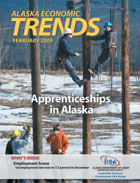
Young Alaskans today have many career options after high school. Some jump right into a job that requires basic skills while others continue with vocational education or college. An important and often overlooked option is taking part in a registered apprenticeship program. Roughly 11,000 young Alaskans join the working-age population each year and are in need of education and training. Those youth have to compete with people who are unemployed, estimated at nearly 28,000 for Alaska in December 2008, and a national labor force that sends thousands of nonresident workers to Alaska each year to fill jobs that require a significant skill level.
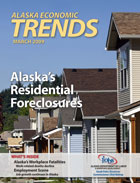
Housing experts across the nation are comparing current housing woes and foreclosure rates to those of the Great Depression. But you don't have to be an octogenarian to remember such hard times for the Alaska housing market. The recent spate of foreclosures in the national headlines may remind a few sourdoughs of the late 1980s bust in Alaska when jobs were slashed, entire residential blocks were turned over to the banks and more than 8 percent of the state's population fled to the Lower 48.
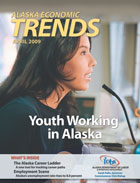
Teenagers and young adults face many rites of passage: they get their driver's license, they register to vote, and they show up for work at their first part-time or summer job. Though that first job may put only a few dollars in their pockets, the experience and skills they learn can prepare them for successful long-term careers.
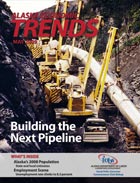
A gas line from Prudhoe Bay to the contiguous lower 48 is still on [the president's] energy list. He has submitted an energy reorganization plan which creates a federal inspector to supervise the enforcement of permit regulations during the construction of the 4,748-mile-long gas line. The plan also calls for a seven member policy board to monitor construction." Alaska Economic Trends, May 1979 The topic of constructing and operating a transportation system to move North Slope natural gas to the Lower 48 is obviously not a new one. The president referred to above was Jimmy Carter, and a lot has changed since then.
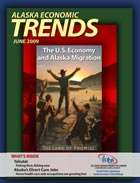
Historically, when national recessions have driven the U.S. unemployment rate above 7 percent, Alaska's population gains from migration have also spiked. The U.S. rate has been above 7 percent since last December and reached 9.4 percent in May. For at least the next year any improvement in the nation's jobless picture is unlikely. Despite the national recession, Alaska has fared relatively well so far. Through April, Alaska and North Dakota were the only two states still showing over-the-year job growth. Given this and other circumstances, it's hard to imagine that Alaska won't become a bigger draw for folks looking for job opportunities.
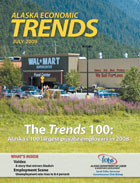
For the second year in a row, Providence Health & Services in 2008 topped the list as Alaska's only private-sector employer with more than 4,000 employees. They're likely to remain at the top of the list and alone in the 4,000-plus category for many years to come. Wal-Mart/Sam's Club joined Carrs/Safeway as an Alaska employer with a work force larger than 3,000. In fact, Wal-Mart snuck by Carrs/Safeway to become Alaska's second-largest employer in 2008. Wal-Mart got there by expanding existing stores into supercenters - in Fairbanks, Mat-Su and Anchorage - rather than by opening new stores.
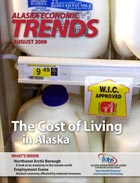
In Alaska, oil prices are usually discussed in the context of their impact on state revenue and budgets. With no state sales or income taxes, oil generates the dominant share of what state government spends. But oil prices also have a large effect on consumer prices in a state where heating homes and transporting goods are major expenses. Oil prices shot up above $140 in 2008 before falling back to around $30 later in the same year. That unprecedented volatility affected Alaskans? household expenses in a variety of ways.
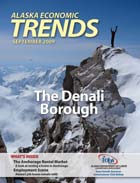
The economic fundamentals of the Denali Borough have changed little since it was created in 1990. The basic economic sectors of this small borough of 1,848 residents were largely in place in 1990. Clear Air Force Station had been operating since 1961. Denali National Park and Preserve, created in 1917, had already existed for some 70 years. The Usibelli Coal Mine had been mining coal since 1943; it started exporting it to South Korea in 1985. And a power plant in the borough had been generating power for Fairbanks and elsewhere in the Interior since 1967.
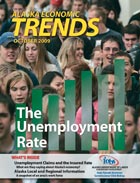
People interested in the economy - and who isn't these days? - know that the U.S. unemployment rate has soared over the last year and a half. The Federal Reserve, investors and politicians are among those watching the rate closely for signs that the country is emerging from a deep national recession.
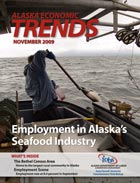
Alaska is once again the nation's No. 1 fishing state, a position it's held since 1975. The state's 2008 harvest, worth a record $1.7 billion, topped the state's previous record - $1.66 billion in 1992 - and was 4.3 times the value of the nation's No. 2 fishing state, Massachusetts.
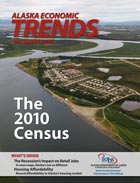
If the U.S. Census Bureau wants to count Alaskans living in remote areas they've got to be flexible enough to show up when people are home and that's exactly what they're planning to do. On Jan. 25, 2010 - before spring breakup and when many rural Alaskans head off to their fish camps - Census Bureau Director Robert Groves plans to personally fly to Noorvik, to meet and tally the first residents in the nation to be counted for Census 2010.
